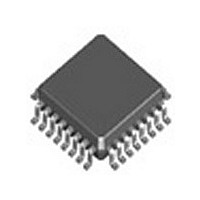DJLXT384LE.B1SE001 Intel, DJLXT384LE.B1SE001 Datasheet - Page 53

DJLXT384LE.B1SE001
Manufacturer Part Number
DJLXT384LE.B1SE001
Description
Manufacturer
Intel
Datasheet
1.DJLXT384LE.B1SE001.pdf
(140 pages)
Specifications of DJLXT384LE.B1SE001
Screening Level
Industrial
Mounting
Surface Mount
Operating Temperature (min)
-40C
Operating Temperature (max)
85C
Lead Free Status / RoHS Status
Not Compliant
- Current page: 53 of 140
- Download datasheet (2Mb)
6.4.2
Document Number: 248994
Revision Number: 005
Revision Date: November 28, 2005
Figure 5. 50% AMI Encoding
Note: The TAOS generator uses MCLK as a timing reference. To ensure that the output frequency is
Note: The TAOS generator uses MCLK as a timing reference. To ensure that the output frequency is
If TCLK:
Zero suppression is available only in Unipolar Mode. The zero-suppression type is HDB3 (E1
environment) or B8ZS (T1 environment). The scheme selected depends on whether the device is
set for T1 or E1 operation (determined by LEN2-0 pulse shaping settings). The LXT384
Transceiver also supports AMI line coding/decoding as shown in
Each output driver is supplied by its own TVCC and TGND power-supply pins. The transmit pulse
shaper is bypassed if no MCLK is supplied. When in this condition, if TCLK is pulled High, then
TPOS and TNEG control the pulse width and polarity on TTIP and TRING. With MCLK supplied
and TCLK pulled High, the driver enters TAOS (Transmit All Ones pattern).
within specification limits, MCLK must have the applicable stability. TAOS is inhibited during
Remote Loopback.
Transmitter Pulse Shaping
Pulse shaping is a means of converting an input logic ‘1’ into a valid output mark so that the output
pulse can be changed (or ‘shaped’) to adhere to the ITU-T G.703 pulse template (shown in
31
The transmit pulse shaper is bypassed if no MCLK is supplied. In this case, if TCLK is pulled high
then TPOS and TNEG control the pulse width and polarity on TTIP and TRING. With MCLK
supplied and TCLK pulled High, the driver enters TAOS (Transmit All Ones pattern).
within specification limits, MCLK must have the applicable stability. TAOS is inhibited during
Remote Loopback.
•
•
•
•
TRING
TTIP
in
Is not supplied, the transmitter output remains powered down and the TTIP/TRING outputs
are held in a high-impedance tristate. Fast output tristatability is also available through the OE
pin (all ports) or the port’s OEx bit in the Output Enable Register (OER).
Is supplied, the input signals that the transmitter samples depends on the TNEG/UBS setting.
When TNEG/UBS is connected:
In Hardware mode, use the CODEN pin to select AMI coding/decoding.
In host mode, bit 4 in the GCR (Global Control Register) selects AMI coding/decoding.
— Low (bipolar I/O), the transmitter samples TPOS/TNEG input signals on the falling edge
— High for more than 16 consecutive TCLK cycles (unipolar I/O), the transmitter samples
Chapter 13.0, “Mask
of TCLK.
TDATA inputs on the falling edge of TCLK.
Bit Cell
1
Specifications”).
0
Intel
®
LXT384 Octal T1/E1/J1 S/H PCM Transceiver with JA
1
Figure
5.
Figure
53
Related parts for DJLXT384LE.B1SE001
Image
Part Number
Description
Manufacturer
Datasheet
Request
R

Part Number:
Description:
Microprocessor: Intel Celeron M Processor 320 and Ultra Low Voltage Intel Celeron M Processor at 600MHz
Manufacturer:
Intel Corporation

Part Number:
Description:
Intel 82550 Fast Ethernet Multifunction PCI/CardBus Controller
Manufacturer:
Intel Corporation
Datasheet:

Part Number:
Description:
Intel StrataFlash memory 32 Mbit. Access speed 120 ns
Manufacturer:
Intel Corporation
Datasheet:

Part Number:
Description:
Intel StrataFlash memory 32 Mbit. Access speed 120 ns
Manufacturer:
Intel Corporation
Datasheet:

Part Number:
Description:
Intel StrataFlash memory 64 Mbit. Access speed 150 ns
Manufacturer:
Intel Corporation
Datasheet:

Part Number:
Description:
Intel StrataFlash memory 32 Mbit. Access speed 100 ns
Manufacturer:
Intel Corporation
Datasheet:

Part Number:
Description:
DA28F640J5A-1505 Volt Intel StrataFlash Memory
Manufacturer:
Intel Corporation
Datasheet:

Part Number:
Description:
5 Volt Intel StrataFlash?? Memory
Manufacturer:
Intel Corporation
Datasheet:

Part Number:
Description:
5 Volt Intel StrataFlash?? Memory
Manufacturer:
Intel Corporation

Part Number:
Description:
Intel 6300ESB I/O Controller Hub
Manufacturer:
Intel Corporation
Datasheet:

Part Number:
Description:
Intel 82801DB I/O Controller Hub (ICH4), Pb-Free SLI
Manufacturer:
Intel Corporation
Datasheet:

Part Number:
Description:
Intel 82801FB I/O Controller Hub (ICH6)
Manufacturer:
Intel Corporation
Datasheet:

Part Number:
Description:
Intel Strataflash Memory28F128J3 28F640J3 28F320J3
Manufacturer:
Intel Corporation
Datasheet:











